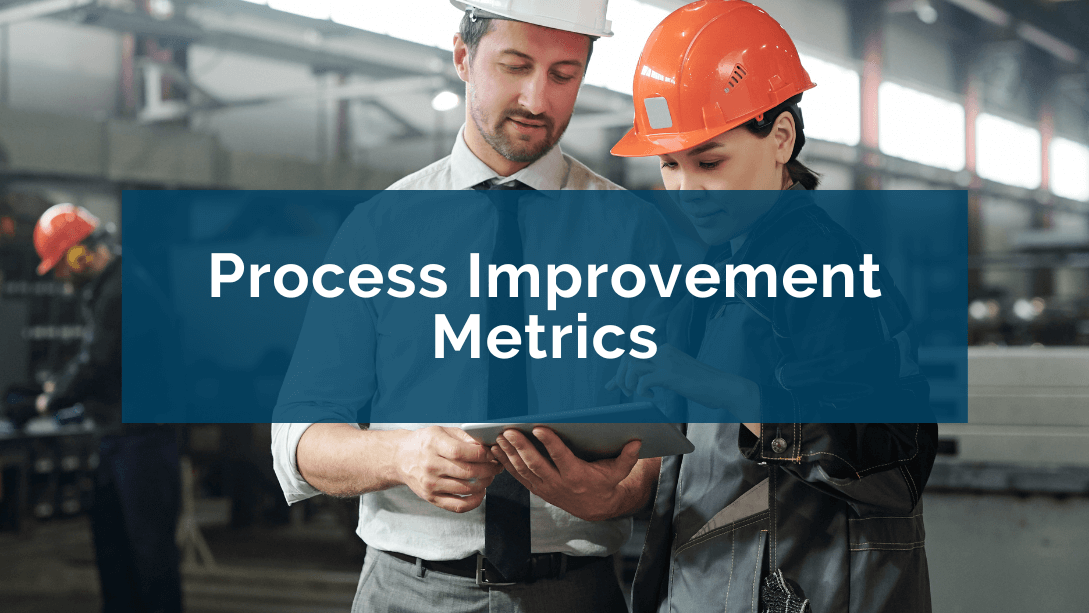What are process improvement metrics?
Manufacturing process improvement metrics are vital for measuring the overall performance of any organization in this industry. Indeed, these specific metrics make it possible to measure, analyze, and adjust each stage of operations to generate smoother, more efficient production.
Like key performance indicators (KPIs), process-specific indicators are continuous improvement metrics. Still, their focus is different: they aim to optimize production flows by tracking data such as cycle time, yield rate, or Overall Equipment Effectiveness (OEE).
- Process improvement metrics = Performance of specific activities within a production process. They are more focused on internal operations.
- Key performance indicators (KPIs) = Overall company performance compared to its objectives.
Process performance metrics are indispensable strategic tools, providing a reliable basis for improving operations and business processes.
Why is it important to monitor process metrics?
- Process optimization
- Quality of products and services delivered to customers
- Better customer satisfaction
- Informed decisions
- Contribution to continuous improvement
15 Key metrics to measure process improvement
There are multiple types of process performance metrics. Here are the most commonly used in manufacturing organizations:

Operational performance indicators
1. Cycle time
Total time required to complete a task or process from start to finish.
Example: In a car manufacturing plant, if each vehicle takes 8 hours to assemble, the cycle time from the start of the assembly process to the end of the production line is 8 hours.
2. Yield rate
Quantity of compliant parts generated compared to raw material or resources used.
Example: If a factory produces 950 compliant items out of 1,000 parts manufactured, the yield rate is 95%.
3. Net output
Actual production compared to theoretical production capacity in a given time.
Example: If a line can produce 500 parts daily but only produces 450, the net production rate is 90%.
4. On Time Delivery (OTD)
Percentage of orders delivered on time.
Example: If a company processes 200 orders and delivers 180 on time, the OTD is 90%.
5. Lead time
Time elapsed between the order of an item and its delivery to the customer.
Example: A company can have a lead time of 5 days if it receives an order on Monday and delivers it on Friday.
Quality indicators
6. Defect rate
Percentage of non-conforming or defective parts compared to the standard out of the total number of parts manufactured.
Example: If a production line produces 10,000 units per month, and if 200 of them are defective, the defect rate is 2%.
7. Internal non-conformance rate
Percentage of items rejected during internal checks before delivery.
Example: If a production line produces 1,000 units and 50 are rejected internally, the non-conformity rate is 5%.
8. Scrap rate
Quantity of discarded or unusable items after production compared with the total manufactured.
Example: If a plant produces 10,000 units but rejects 500, the reject rate is 5%. Reducing this rate will improve process efficiency.
Equipment and resource efficiency indicators
9. Overall Equipment Effectiveness (OEE)
Overall Equipment Effectiveness is based on three factors: availability, performance, and quality. It measures machine performance on a purely technical level.
Example: If a machine operates 80% of the time with 90% performance and 95% quality, the OEE is 68.4%, i.e. 0.80 x 0.90 x 0.95.
10. Total Effective Equipment Performance (TEEP)
Broader than OEE, this indicator includes machine efficiency and that of teams and processes. It considers the same three factors as OEE (availability, performance, quality).
Example: If a machine is available 90% of the time, operates at 80% of its capacity, and produces 95% of compliant parts, the TEEP would be 68.4%, i.e. 0.90 x 0.80 x 0.95.
11. Resource utilization rate
Efficiency with which resources (labor, machines, raw materials) are used.
Example: If a machine is used for 40 hours out of a total capacity of 50 hours, the utilization rate is 80%.
12. Downtime
Time when a machine or process is inactive due to breakdowns or interruptions.
Example: If a production line is idle for 4 hours out of an 8-hour working day, the downtime is 50%.
13. Failure frequency rate
Frequency with which equipment breaks down over a given period.
Example: A production machine operates 8 hours daily for 20 days per month. If it experiences five breakdowns during the month, the breakdown frequency rate is five breakdowns for 160 hours of operation (8 hours x 20 days), i.e., one breakdown every 32 hours of production.
Financial and economic indicators
14. Cost per unit produced
Total cost of production divided by the number of units produced.
Example: If a company spends $50,000 to produce 5,000 units, the cost per unit is $10.
15. Return On Investment (ROI)
Benefits obtained from improvement projects compared to the costs incurred.
Example: If a company invests $10,000 in an improvement project and generates $15,000 in gains, the ROI is 50%.
Tips to choose the right metrics
To select strategic process performance metrics, it is essential to align them with the company's operational objectives. In other words, indicators must directly reflect current priorities: cost reduction, quality improvement, increased productivity, etc.
Here are some key criteria to consider:
- Relevance and specificity: The chosen indicators must be directly linked to the processes you want to optimize. For example, OEE would be a relevant indicator if you want to improve machine productivity.
- Data reliability: Indicators must be based on objective, verifiable information to guarantee accurate measurement. Ensure that data sources are credible and the collection process is well established.
- Ability to act: Indicators must enable rapid and effective action in the event of deviations.
- Adaptability to change: Indicators must be regularly reassessed to ensure they remain aligned with current objectives and priorities.
- Simplicity: Indicators must be easy to understand for all stakeholders, so they can be used smoothly daily. They must be self-explanatory and not require overly complex calculations.
How to measure and improve business process efficiency

1. Define your improvement objectives
Before measuring the processes, it's essential to understand why you're doing it. What do you want to improve? Have you noticed recurring variances? Remember that where there is a problem, there is always an opportunity for improvement. For example, if you've seen a drop in the number of units produced in your plant, your objective could be to increase productivity.
Pro tip: Setting SMART goals will help you better assess progress and celebrate successes.
2. Identify the right indicators
Selecting relevant metrics to monitor the performance of the existing processes is imperative for your strategic planning. The chosen metrics should be aligned with your improvement objectives and enable you to accurately assess the processes' efficiency.
3. Collect reliable data in real-time
Use process mining tools such as MES (Manufacturing Execution Systems) and ERP (Enterprise Resource Planning), and operational dashboards to collect data on the processes you wish to improve. The data must be accurate for the analysis to be reliable. Software integration can greatly simplify real-time data collection and analysis.
Business Process Management (BPM) tools can also help centralize and display process improvement metrics on dashboards, providing a clear view of performance and facilitating informed decision-making.
4. Analyze results
Once the data has been collected, compare the results with your improvement objectives. At this stage, you'll notice deviations from set objectives; you need to understand why they occur (bottlenecks, errors, breakdowns, etc.). Many problem-solving methods are available to manufacturers to facilitate and accelerate the identification of possible causes.
5. Implement improvement plans
After result analysis comes the implementation of improvement plans. Process improvement efforts may include changes to maintenance, improved working methods, or the purchase of new equipment, for instance.
By acting on the data collected, you can effectively improve processes and ensure that your production is aligned with operational goals.
6. Monitor and adjust
Metrics need to be monitored over the long term. Companies can measure the success of their action plans by tracking process performance metrics and adjusting their strategies to ensure continuous improvement.
Combine process improvement metrics with UTrakk to achieve operational excellence
Process improvement metrics are essential for measuring process efficiency and operational performance. They provide a clear, objective view of the current situation while helping to identify areas for improvement. However, to maximize their impact, regular, real-time monitoring is crucial.
The UTrakk DMS software is designed to facilitate tracking and analysis of key metrics. The solution dashboards enable you to configure personalized diagrams, creating a comprehensive view to measure necessary data and track progress, easily and efficiently. With data displayed in real time, a manufacturing company can quickly act on variances and take corrective actions to ensure smooth operations and process optimization over the long term. UTrakk is a competitive advantage for data-driven decision making, actionable insights, and continuous improvement.
By combining process improvement metrics with the UTrakk solution, organizations strengthen their ability to improve operations, guaranteeing sustainable performance and operational excellence.









